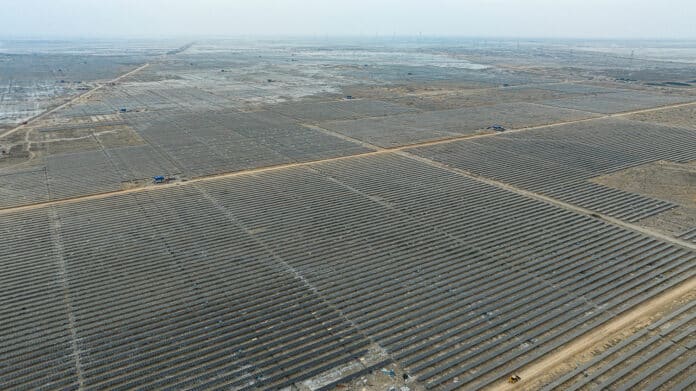Renewable electricity is growing faster in India than in any other major economy. The country is set to host one of the world’s largest clean energy farms, reducing dependence on fossil fuels in energy generation.
Adani Green Energy Limited has achieved a significant milestone by operationalizing a cumulative capacity of 1,000 MW of solar energy at the world’s largest renewable energy park in Khavda, Gujarat. This achievement came less than 12 months after commencing work at Khavda, which involved installing approximately 2.4 million solar modules.
Adani Green Energy Limited has demonstrated its commitment to India’s goal of achieving 500 GW of non-fossil fuel capacity by 2030 by continuing its journey towards the stated goal of 45,000 MW.
The world’s largest renewable energy plant, 30 GW, spans a staggering 538 sq km of barren land, five times the size of Paris. The region witnesses about 2,060 kWh/m2 of high solar irradiation and one of the best wind resources in India, with speeds of approximately 8 meters per second. The project is expected to be completed in the next five years and will create over 15,200 green jobs and help reduce our carbon footprint.
The plant will be equipped with cutting-edge technology, such as India’s largest onshore wind turbine generator and bifacial solar PV modules. The concept of horizontal single-axis tracker systems that track the sun to collect more energy is interesting.
The integration of Artificial Intelligence and Machine Learning in Adani’s Energy Network Operation Centre (ENOC) platform for real-time automated operation and monitoring of the plant is indeed a great example of technological advancement in the energy sector.
The renewable energy project aims to generate 81 billion units of clean electricity. This will provide sustainable power to around 16.1 million households. The best part of this initiative is that it will help combat climate change by avoiding 58 million tons of CO2 emissions. This is equivalent to the carbon sequestration of 2,761 million trees.
It is comparable to preventing the burning of 60,300 tonnes of coal and taking approximately 12.6 million cars off the roads. This demonstrates the magnitude of the project‘s impact on mitigating greenhouse gas emissions and promoting a cleaner, healthier planet.
The company is implementing some advanced technologies to improve the efficiency and durability of the plant. One such technology is the use of subterranean stone columns to strengthen the soil, which is a result of international collaboration with participation from domestic and foreign higher education institutions. Additionally, the solar module mounting structures and switchyard equipment are coated with corrosion-resistant materials to protect them from the harsh environment.
